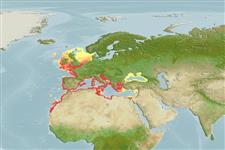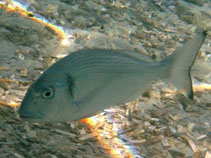個人による観察記録の追加 Fish Watcher
| Native range | All suitable habitat | Point map | Year 2050 |

|
| This map was computer-generated and has not yet been reviewed. |
| Sparus aurata AquaMaps Data sources: GBIF OBIS |
Upload your 写真 and ビデオ
Pictures | Videos | Stamps, coins, misc. | グーグルの画像Sparus aurata
Picture by Pillon, R.
Pictures | Videos | Stamps, coins, misc. | グーグルの画像Sparus aurata
Picture by Pillon, R.
Slovenia country information
Common names:
Orada
Occurrence: native
Salinity: marine
Abundance: | Ref:
Importance: | Ref:
Aquaculture: commercial | Ref: FAO, 1997
Regulations: | Ref:
Uses: no uses
Comments: Also Ref. 4781. Status of threat: insufficiently known in Adriatic river basin (Ref. 90061).
National Checklist:
Country Information: https://www.cia.gov/library/publications/resources/the-world-factbook/geos/si.html
National Fisheries Authority:
Occurrences: Occurrences Point map
Main Ref: Povz, M., 1996
National Database:
Occurrence: native
Salinity: marine
Abundance: | Ref:
Importance: | Ref:
Aquaculture: commercial | Ref: FAO, 1997
Regulations: | Ref:
Uses: no uses
Comments: Also Ref. 4781. Status of threat: insufficiently known in Adriatic river basin (Ref. 90061).
National Checklist:
Country Information: https://www.cia.gov/library/publications/resources/the-world-factbook/geos/si.html
National Fisheries Authority:
Occurrences: Occurrences Point map
Main Ref: Povz, M., 1996
National Database:
Common names from other countries
分類 / Names 共通名の | 類義語 | Catalog of Fishes(部類, 種) | ITIS | CoL | WoRMS | Cloffa
> Eupercaria/misc (Various families in series Eupercaria) > Sparidae (Porgies)
Etymology: Sparus: Latin, sparus = a fish with a golden head (Ref. 45335).
More on author: Linnaeus.
Etymology: Sparus: Latin, sparus = a fish with a golden head (Ref. 45335).
More on author: Linnaeus.
Issue
There has been much confusion in the past literature between the names Chrysophrys aurata/us, Pagrus aurata/us and Sparus aurata/us, that were used for two different species: Sparus aurata Linnaeus, 1758 from the Northeast and Central Atlantic, Pagrus auratus (Forster, 1801) from the West Pacific on one other side on the other side. Check the geographic origin of specimens when these names are used in the literature.
Environment: milieu / climate zone / depth range / distribution range 生態学
海; 汽水性の 底生の; 深さの範囲 1 - 150 m (Ref. 35388), usually 1 - 30 m (Ref. 54890). Subtropical; 62°N - 15°N, 17°W - 43°E (Ref. 54890)
分布 国々 | 国連食糧農業機関の区域 | エコシステム | 事件 | Point map | 導入 | Faunafri
Eastern Atlantic: British Isles, Strait of Gibraltar to Cape Verde and around the Canary Islands; also in the Mediterranean (Ref. 3688). Reported from the Black Sea (Ref. 12781). Reports from New Zealand refer to Pagrus auratus (Foster 1801) (Ref. 5755, 9258).
Length at first maturity / サイズ / 重さ / 年齢
Maturity: Lm 36.5, range 33 - 40 cm
Max length : 70.0 cm TL オス/雌雄の選別がない; (Ref. 35388); common length : 35.0 cm SL オス/雌雄の選別がない; (Ref. 4781); 最大公表体重: 17.2 kg (Ref. 40637); 最大記録サイズ: 11 年 (Ref. 7253)
Max length : 70.0 cm TL オス/雌雄の選別がない; (Ref. 35388); common length : 35.0 cm SL オス/雌雄の選別がない; (Ref. 4781); 最大公表体重: 17.2 kg (Ref. 40637); 最大記録サイズ: 11 年 (Ref. 7253)
簡単な記述 検索表 | 形態学 | 形態計測学
背面の脊椎 (合計) : 11; 背鰭 (合計) : 13 - 14; 肛門の骨: 3; 臀鰭: 11 - 12. Body tall, with large black spot on the gill cover. Snout more than twice as long as the eye diameter (Ref. 35388).
Found in seagrass beds and sandy bottoms as well as in the surf zone commonly to depths of about 30 m, but adults may occur to 150 m depth. A sedentary fish, either solitary or in small aggregations. In spring, they often occur in brackish water coastal lagoons and estuaries. Mainly carnivorous, accessorily herbivorous (Ref. 3688). Feed on shellfish, including mussels and oysters. One of the most important fishes in saline and hypersaline aquaculture. Utilized fresh and eaten steamed, pan-fried, broiled, boiled, microwaved and baked (Ref. 9987).
Life cycle and mating behavior 成熟 | 繁殖 | 放精 | 卵 | 生産力 | 幼生
Males become females at about 3 years of age (Ref. 2715, 28504). Protandric hermaphrodite species, maturing first as male (during the first or second year of age) and after the second or third year of age, as female. Spawning happens generally from October to December, with sequenced spawning during the whole period. Incubation lasts about 2 days at 16-1 7°C. Larval stages last about 50 days at 1 7.5°C or about 43
days at 20°C. Egg size 0.9-1.1 mm, larval length at hatching 2.5-3.0 mm. Simultaneous hermaphroditism is suggested for this species (Ref. 103751).
主な参考文献
Upload your references | 参考文献 | コーディネーター | 協力者
Bauchot, M.-L. and J.-C. Hureau, 1990. Sparidae. p. 790-812. In J.C. Quero, J.C. Hureau, C. Karrer, A. Post and L. Saldanha (eds.) Check-list of the fishes of the eastern tropical Atlantic (CLOFETA). JNICT, Lisbon; SEI, Paris; and UNESCO, Paris. Vol. 2. (Ref. 3688)
人間に対する脅威
Harmless
Human uses
水産業: 商業; 水産養殖: 商業; ゲームフィッシュ: はい
FAO(Aquaculture systems: 代謝, 種の外形; 水産業: 代謝, 種の外形; publication : search) | FIRMS (Stock assessments) | FishSource | 私達の周りの海
より多くの情報
Population dynamics
成長のパラメーター
Max. ages / sizes
Length-weight rel.
Length-length rel.
体長組成
Mass conversion
補充
豊度
成長のパラメーター
Max. ages / sizes
Length-weight rel.
Length-length rel.
体長組成
Mass conversion
補充
豊度
Anatomy
カマ
Brain
Otolith
カマ
Brain
Otolith
Physiology
Body composition
Nutrients
酸素消費
水泳形態
泳ぐ速さ
Visual pigments
Fish sound
Diseases & Parasites
Toxicity (LC50s)
Body composition
Nutrients
酸素消費
水泳形態
泳ぐ速さ
Visual pigments
Fish sound
Diseases & Parasites
Toxicity (LC50s)
用具
Bio-Quiz | E-book | 野外観察図鑑 | 検索表 | Length-frequency wizard | 生活史の基盤ツール | 目的のマップ | Classification Tree
| Catch-MSY |
特記事項
XMLをダウンロードして下さい
インターネットの情報源
Alien/Invasive Species database | Aquatic Commons | BHL | Cloffa | Websites from users | Check FishWatcher | CISTI | Catalog of Fishes(部類, 種) | DiscoverLife | DORIS | ECOTOX | Faunafri | Fishtrace | GenBank(ゲノム, ヌクレオチド) | GloBI | GOBASE | | Google Books | Google Scholar | Google | IGFA World Record | MitoFish | 国のデーターベース | Otolith Atlas of Taiwan Fishes | 公共の水族館 | PubMed | Reef Life Survey | Scirus | SeaLifeBase | 生命の木 | Wikipedia(行く, 検索する) | World Records Freshwater Fishing | Zoobank | 動物に関する記録
Estimates based on models
Preferred temperature (Ref. 115969): 12.1 - 21, mean 17.8 (based on 258 cells).
Phylogenetic diversity index (Ref. 82804): PD50 = 1.0000 [Uniqueness, from 0.5 = low to 2.0 = high].
Bayesian length-weight: a=0.01202 (0.01085 - 0.01332), b=3.02 (2.99 - 3.05), in cm Total Length, based on LWR estimates for this species (Ref. 93245).
栄養段階 (Ref. 69278): 3.7 ±0.0 se; based on diet studies.
回復力 (Ref. 120179): 手段, 1.4年~4.4年の倍増期間の最小個体群 (K=0.28; tmax=11; tm=2-3).
Prior r = 0.57, 95% CL = 0.37 - 0.85, Based on 7 data-limited stock assessments.
Fishing Vulnerability (Ref. 59153): Low to moderate vulnerability (35 of 100).
Climate Vulnerability (Ref. 125649): Moderate vulnerability (41 of 100).




